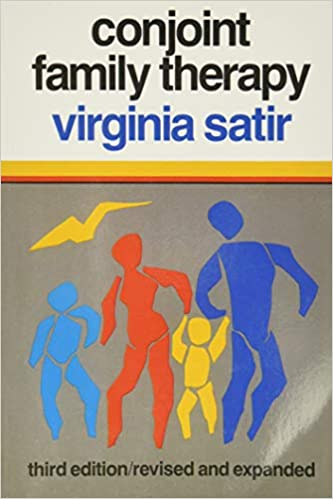Vlll studies, my account is not a final analysis. Instead, it captures my excitement about the approach and about the work I did with the nine other members of my team. The project’s results will have many implications for family therapists, and readers may want to consider using this “larger systems” approach if they have the opportunity. An “Author’s Note” and a new bibliography complete this new edition. The note describes my other training materials and how they can be used in conjunction with this book. It also provides information on Avanta, a training program I created. * * * * * This book grew out of demands for teaching materials for a course in Family Dynamics which I taught to psychiatric residents at the Illinois State Psychiatric Institute in Chicago from 1955 to 1958. Since that time, many of my colleagues from the fields of medicine, psychiatry, psychology, social work, nursing, education, anthropology and sociology have expressed interest in my training programs in family therapy and have encouraged me to expand my initial training outlines and put them in book form. This book is the result, and represents the conclusions I have reached to date on the difficult and challenging subject of conjoint family therapy. Many major contributions have been made to the use of the family as a therapeutic unit by people who saw behavior as a result of interactional experience in addition to intra-psychic forces. I was one of many who experimented with observing the person labeled “schizophrenic” in the presence of his family, rather than by individual treatment alone. The germ of my particular theory and practice grew out of a new appraisal of the meaning of relatives’ calls to me about the “patient” I was seeing. These calls were ostensibly in the form of complaints about the patient, or about my handling, or reports about things they thought I should know about. In traditional psychotherapeutic practice, I had been taught to view any attempt by a relative to communicate with the therapist as a potentially dangerous obstacle to the treatment relationship. As I began to try to understand the meaning of these calls, I saw that there were at least two messages conveyed in them: one about the pain or trouble that the relative observed in the patient, and one about the pain and trouble in himself
چکیده فارسی
Vllll مطالعه می کند، حساب من تجزیه و تحلیل نهایی نیست. در عوض، هیجان من را در مورد رویکرد و کاری که با 9 عضو دیگر تیمم انجام دادم را به تصویر می کشد. نتایج این پروژه پیامدهای زیادی برای خانوادهدرمانگران خواهد داشت و خوانندگان ممکن است بخواهند در صورت داشتن فرصت، از این رویکرد «سیستمهای بزرگتر» استفاده کنند. یک "یادداشت نویسنده" و یک کتابشناسی جدید این نسخه جدید را تکمیل می کند. این یادداشت سایر مطالب آموزشی من و نحوه استفاده از آنها را در ارتباط با این کتاب شرح می دهد. همچنین اطلاعاتی در مورد آوانتا، یک برنامه آموزشی که من ایجاد کردم، ارائه می دهد. * * * * * این کتاب ناشی از تقاضا برای مواد آموزشی برای دوره دینامیک خانواده است که من از سال 1955 تا 1958 به دستیاران روانپزشکی در مؤسسه روانپزشکی ایالتی ایلینویز در شیکاگو تدریس کردم. از آن زمان، بسیاری از همکاران من در این زمینه رشته های پزشکی، روانپزشکی، روانشناسی، مددکاری اجتماعی، پرستاری، آموزش، مردم شناسی و جامعه شناسی به برنامه های آموزشی من در خانواده درمانی ابراز علاقه کرده اند و مرا تشویق کرده اند که طرح های اولیه آموزشی خود را گسترش داده و آنها را در قالب کتاب قرار دهم. این کتاب نتیجه است و بیانگر نتایجی است که من تا به امروز در مورد موضوع دشوار و چالش برانگیز خانواده درمانی مشترک به دست آورده ام. کمک های عمده بسیاری به استفاده از خانواده به عنوان یک واحد درمانی توسط افرادی که رفتار را علاوه بر نیروهای درون روانی، نتیجه تجربه تعاملی می دانستند، انجام شده است. من یکی از بسیاری از افرادی بودم که به جای درمان انفرادی، فردی را که برچسب «اسکیزوفرنیک» نامیده شده بود، در حضور خانواده اش مشاهده کردم. نطفه نظریه و عمل خاص من از یک ارزیابی جدید از معنای تماس های بستگان با من در مورد "بیمار"ی که می دیدم رشد کرد. این تماسها ظاهراً بهصورت شکایت از بیمار، یا در مورد رفتار من، یا گزارشهایی درباره چیزهایی بود که آنها فکر میکردند باید دربارهشان بدانم. در روش سنتی روان درمانی، به من یاد داده شده بود که هر تلاشی از سوی یکی از بستگان برای برقراری ارتباط با درمانگر را به عنوان یک مانع بالقوه خطرناک برای رابطه درمانی ببینم. وقتی شروع به تلاش برای درک معنای این تماس ها کردم، دیدم که حداقل دو پیام در آنها مخابره می شود: یکی در مورد درد یا مشکلی که یکی از بستگان در بیمار مشاهده کرده است و دیگری در مورد درد و ناراحتی در خودش< /p>
ادامه ...
بستن ...
Author(s): Virginia Satir
Publisher: Science and Behavior Books, Year: 1983
ISBN: 0831400633,9780831400637
ادامه ...
بستن ...










